The Palawan Peacock-Pheasant (Polyplectron napoleonis) is a stunning avian species endemic to Palawan, Philippines lush forests.
With its iridescent plumage and elegant demeanor, this elusive bird has captured the hearts of birdwatchers and conservationists, earning its place as a symbol of the island’s rich biodiversity.
Nestled within the verdant landscapes of Palawan’s tropical forests, the Palawan Peacock-Pheasant emerges as a jewel of the avian kingdom.
Its vibrant hues and intricate feather patterns reflect the complicated tapestry of its habitat, where it thrives amidst dense foliage and hidden clearings.
Join us on a journey to uncover the secrets of the Palawan Peacock-Pheasant as we delve into its ecological significance and behavioral adaptations.
From its mesmerizing courtship displays to its role in maintaining the delicate balance of Palawan’s ecosystems, this magnificent bird offers a glimpse into the wonders of nature’s craftsmanship.
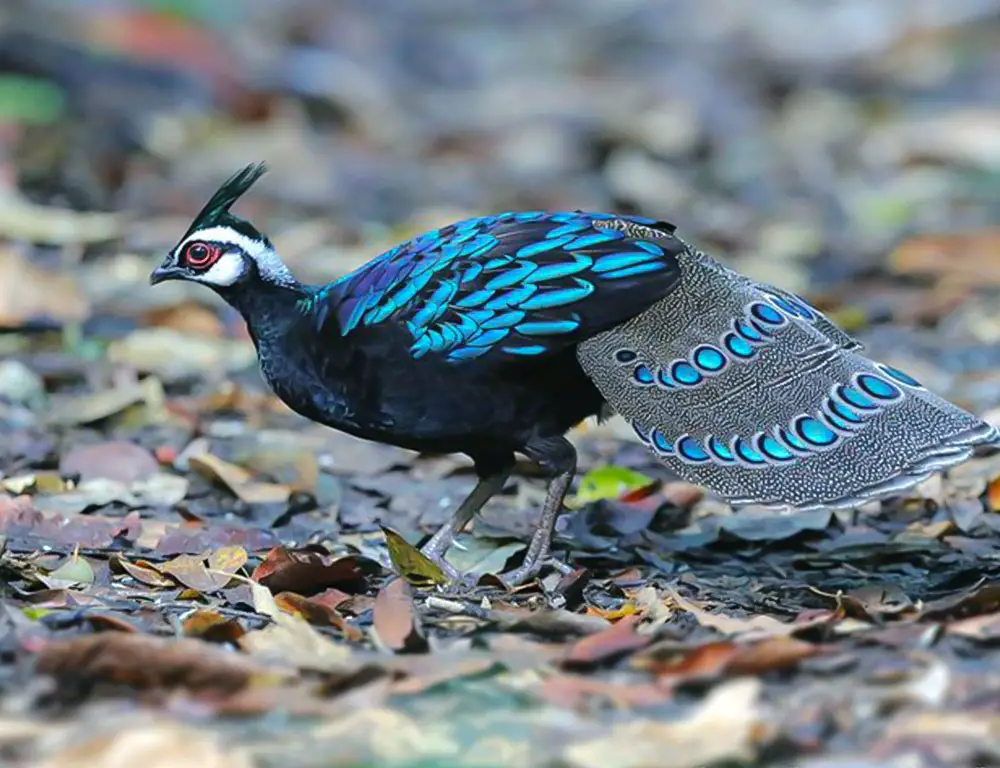
What Are the Key Physical Characteristics of the Palawan Peacock-Pheasant?
Known for its striking appearance and intricate plumage, the Palawan Peacock-Pheasant possesses several vital physical characteristics that distinguish it from other species. Let’s explore these characteristics in detail:
Size and Shape
The Palawan Peacock-Pheasant is a medium-sized bird, with males typically larger than females. On average, males measure around 50 to 65 centimeters (20 to 26 inches) in length, including their tail feathers, while females are slightly smaller.
They have a compact, robust body with a relatively short tail compared to other pheasant species.
Plumage
One of the most distinctive features of the Palawan Peacock-Pheasant is its intricate plumage, characterized by a combination of vibrant colors and intricate patterns.
Males exhibit a striking iridescent blue-green sheen on their upperparts, complemented by a rich chestnut-brown coloration on their underparts.
The head is adorned with a metallic blue-black crown, and the throat features a bold white stripe. Conversely, females have more subdued plumage with brown and buff-colored feathers, providing camouflage during nesting and foraging.
Tail Feathers
The tail feathers of male Palawan peacock pheasants are particularly noteworthy. They possess long, ornate tail feathers that are intricately patterned with eye-like markings reminiscent of peafowl feathers.
During courtship displays, males fan out their tail feathers in a spectacular display to attract females, showcasing their beauty and vitality.
Facial Features
The facial features of the Palawan Peacock-Pheasant are also distinctive. Both males and females have a small crest on their heads, which they can raise or lower depending on their mood or behavior.
Additionally, males have bright red facial skin around their eyes, which becomes more vivid during the breeding season, adding to their striking appearance.
Bill and Legs
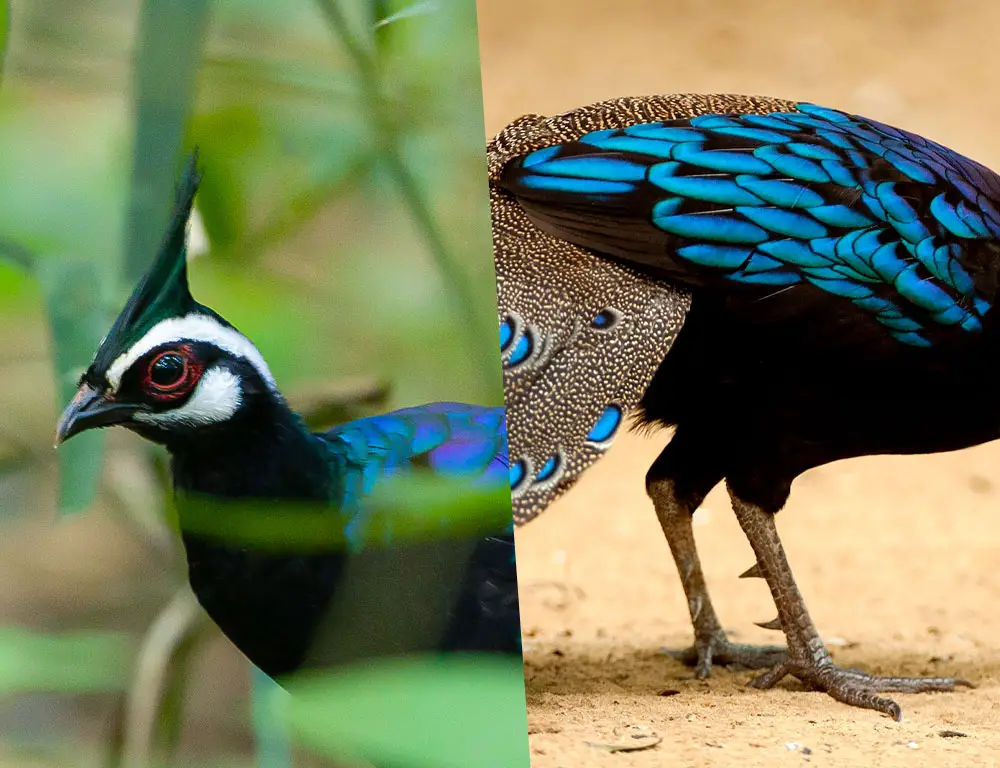
The bill of the Palawan Peacock-Pheasant is short and stout, suited for feeding on various fruits, seeds, and insects. The legs are strong and adapted for walking and scratching for food on the forest floor.
Sexual Dimorphism
As is common in many bird species, there is significant sexual dimorphism between male and female Palawan peacock pheasants.
Males exhibit vibrant and elaborate plumage, including the long ornate tail feathers used in courtship displays to attract mates.
In contrast, females have more subdued plumage, providing camouflage while nesting and caring for their young.
Behavioral Characteristics
In addition to their physical attributes, the Palawan Peacock-Pheasant is known for its secretive behavior and elusive nature.
It is often found foraging on the forest floor in dense undergrowth, using its cryptic plumage to blend in with its surroundings and avoid detection by predators.
During the breeding season, males engage in elaborate courtship displays, which involve fanning their tail feathers and vocalizing to attract females.
A Deeper Look into the Life History of the Palawan Peacock-Pheasant
The Palawan Peacock-Pheasant belongs to the family Phasianidae within the order Galliformes. Here’s a breakdown of its taxonomy:
Taxonomy
| Taxonomy Level | Classification |
| Kingdom | Animalia |
| Phylum | Chordata |
| Class | Aves |
| Order | Galliformes |
| Family | Phasianidae |
| Genus | Polyplectron |
| Species | Polyplectron napoleonis |
Food Habitat
Palawan Peacock-Pheasants have a varied diet consisting of fruits, seeds, buds, insects, and other invertebrates.
They forage primarily on the forest floor, using their stout bills to probe for food in the leaf litter and undergrowth.
Their diet may vary seasonally, depending on the availability of food resources within their habitat.
Nesting
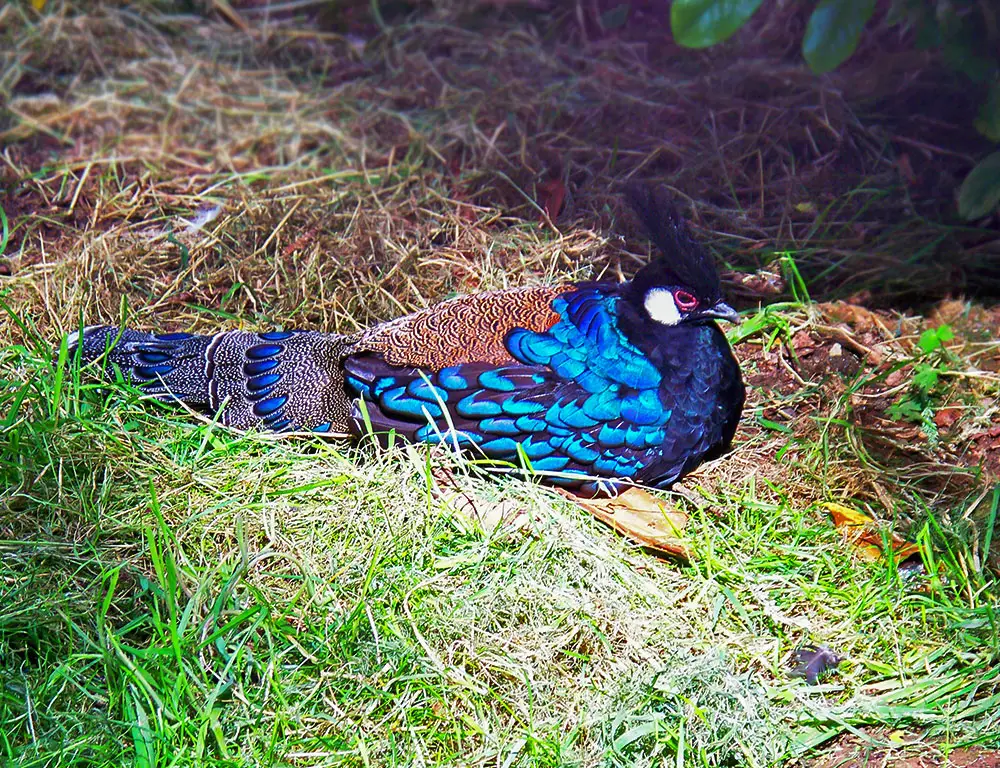
Palawan Peacock-Pheasants construct their nests on the ground, typically concealed among dense vegetation for protection against predators. Here’s a summary of their nesting habits:
| Nesting Habit | Description |
| Nest Location | Ground, hidden in dense vegetation |
| Nest Composition | Leaves, grass, and other plant materials |
| Clutch Size | Typically contains 2-4 eggs |
| Incubation Period | Around 20-24 days |
| Parental Care | Both males and females share incubation and care |
Breeding
Breeding in Palawan peacock pheasants typically occurs during the dry season when food resources are abundant.
Males engage in elaborate courtship displays to attract females, fanning their ornate tail feathers, vocalizing, and performing ritualized movements.
Once a female is attracted, the pair mates, and the female lays a clutch of eggs in the nest. Both parents share the responsibilities of incubating the eggs and caring for the chicks after hatching.
Habitat and Distribution
Palawan peacock pheasants inhabit Palawan Island’s dense forests and mountainous habitats in the Philippines. They are typically found at elevations ranging from sea level to around 1,500 meters above sea level.
Their distribution within their range is influenced by habitat quality, food availability, and the presence of suitable nesting sites.
Range Map and Conservation Status of the Palawan Peacock-Pheasant
Exploring the distribution and conservation status of the iconic Palawan Peacock-Pheasant provides valuable insights into its ecological significance and the challenges in its native habitat.
Let’s delve into its range map and conservation status to understand the efforts aimed at preserving this remarkable species.
Range Map
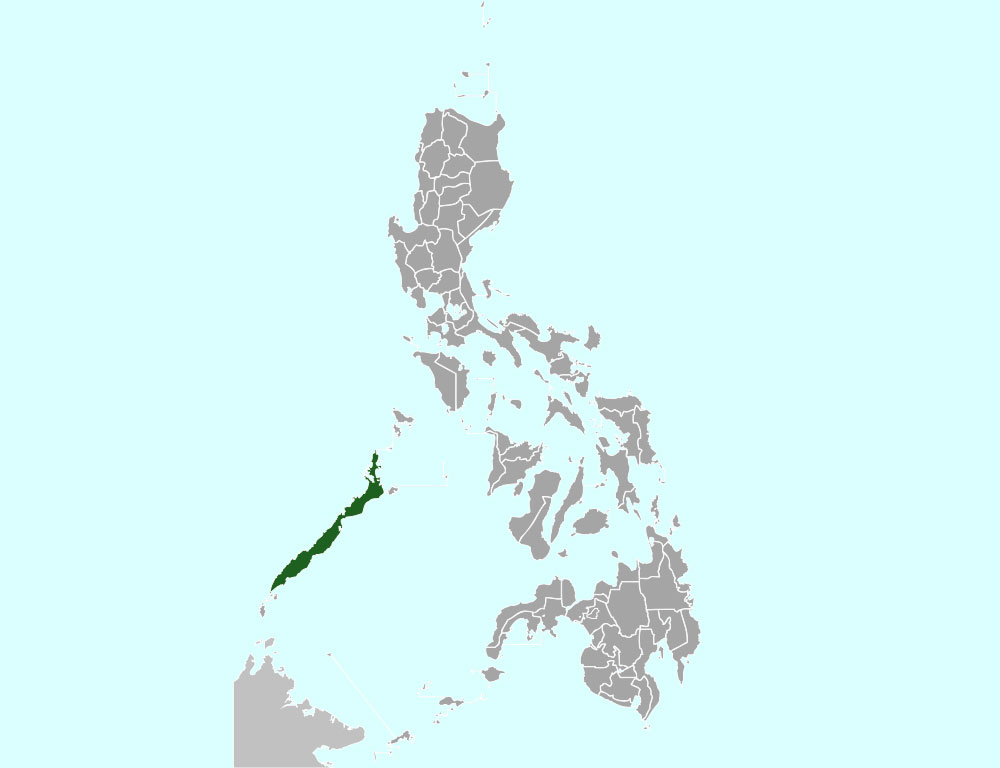
The Palawan Peacock-Pheasant is endemic to the island of Palawan in the Philippines. Its range is primarily confined to the dense forests and montane habitats of Palawan Island, spanning from lowland areas near the coast to higher elevations in the interior.
Within its range, the Palawan Peacock-Pheasant inhabits various forest types, including tropical rainforests, limestone karst forests, and montane forests.
Conservation Status
The Palawan Peacock-Pheasant is listed as “Vulnerable” on the International Union for Conservation of Nature (IUCN) Red List of Threatened Species.
It faces numerous threats to its survival, primarily due to habitat loss, degradation, and fragmentation caused by deforestation, agricultural expansion, and infrastructure development on Palawan Island.
Additionally, the species is vulnerable to hunting and trapping for the illegal wildlife trade, further exacerbating its decline.
What Are the Common Diseases and Treatments of the Palawan Peacock-Pheasant?
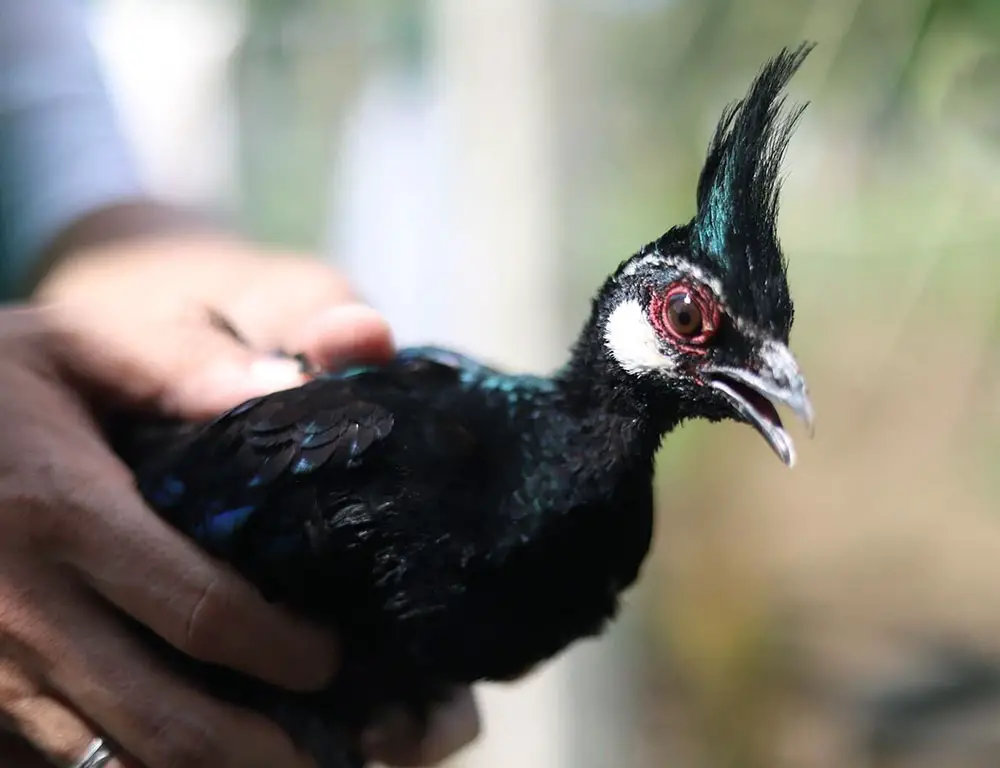
As with any avian species, Palawan peacock pheasants are susceptible to various diseases and health issues. While specific information on the diseases that affect Palawan peacock pheasants may be limited, some common avian ailments and treatments can be generalized:
Respiratory Infections
Like many birds, Palawan peacock pheasants can be vulnerable to respiratory infections caused by bacteria, viruses, or fungi. Symptoms may include nasal discharge, difficulty breathing, and lethargy.
Treatment typically involves antibiotics or antifungal medications prescribed by a veterinarian.
Parasitic Infections
External parasites such as mites and lice, as well as internal parasites like worms, can affect the health of Palawan peacock pheasants. Regular monitoring and treatment with appropriate parasiticides can help control infestations.
Nutritional Deficiencies
Inadequate diet or improper nutrition can lead to health problems in Palawan Peacock-Pheasants, including deficiencies in essential vitamins and minerals. A balanced and varied diet, supplemented if necessary, can help prevent nutritional deficiencies.
Injuries
Palawan Peacock-Pheasants may sustain injuries from encounters with predators, accidents, or territorial disputes. Prompt veterinary care may be required to treat wounds, fractures, or other injuries.
Reproductive Issues
Breeding Palawan peacock pheasants may experience reproductive problems such as egg binding or infertility. Veterinary intervention may be necessary to address these issues and improve breeding success.
Viral Diseases
Certain viral diseases, such as avian influenza or Newcastle disease, can risk Palawan Peacock-Pheasants. Vaccination against specific viral pathogens and biosecurity measures to prevent disease transmission can help mitigate the risk.
Stress-related Conditions
Stressful environmental conditions or captivity-related stress can weaken the immune system of Palawan peacock pheasants, making them more susceptible to diseases.
Providing appropriate habitat, enrichment, and minimizing stressors can help maintain their health and well-being.
5 Fun Facts About the Palawan Peacock-Pheasant
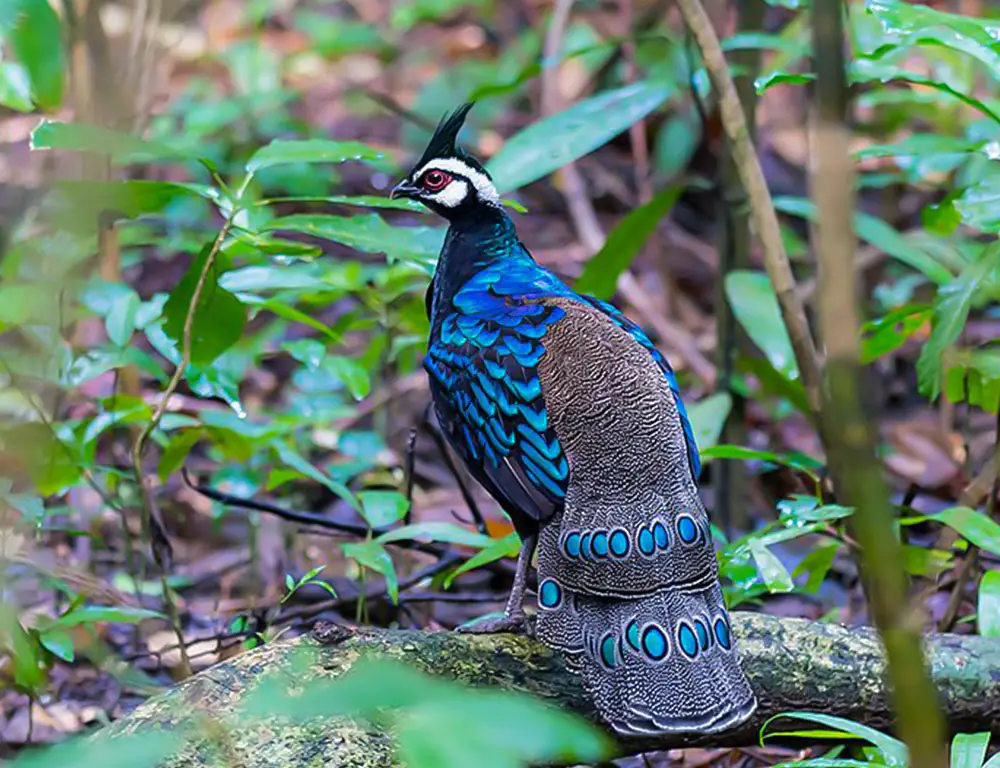
Embark on a journey to discover the captivating world of the Palawan Peacock-Pheasant with these fascinating insights into its behavior and ecology.
1. Elusive Nature
The Palawan Peacock-Pheasant is known for its elusive behavior. It often stays hidden in dense vegetation and difficult-to-access areas of Palawan’s forests, making sightings rare and exciting for birdwatchers.
2. Ornate Plumage
Male Palawan peacock pheasants boast intricate plumage adorned with iridescent hues and striking patterns, including ornate tail feathers with eye-like markings. This elaborate display is used during courtship rituals to attract females.
3. Endemic to Palawan
Found exclusively on the island of Palawan in the Philippines, the Palawan Peacock-Pheasant symbolizes the island’s unique biodiversity and serves as a symbolic species for conservation efforts in the region.
4. Distinctive Courtship Displays
During the breeding season, male Palawan peacock pheasants perform elaborate courtship displays, including vocalizations, fanning out their ornate tail feathers, and engaging in ritualized dances to impress potential mates.
5. Vocal Mimicry
Palawan peacock pheasants are skilled vocal mimics, often imitating sounds from their environment, including the calls of other bird species.
This behavior serves various purposes, from communication to defense against predators, adding to their mystique in the wild.
FAQs
What is a Palawan Peacock-Pheasant?
The Palawan Peacock-Pheasant (Polyplectron napoleonis) is a species of bird endemic to Palawan Island in the Philippines. It is known for its striking plumage and elusive nature.
What does a Palawan Peacock-Pheasant eat?
Palawan Peacock-Pheasants have a varied diet consisting of fruits, seeds, buds, insects, and other invertebrates. They forage primarily on the forest floor, using their stout bills to probe for food in the leaf litter and undergrowth.
Where does the Palawan Peacock-Pheasant live?
The Palawan Peacock-Pheasant inhabits the dense forests and montane habitats of Palawan Island in the Philippines. It is typically found at elevations ranging from sea level to around 1,500 meters above sea level.
Is the Palawan Peacock-Pheasant endangered?
Yes, the Palawan Peacock-Pheasant is listed as “Vulnerable” on the IUCN Red List of Threatened Species. It faces threats like habitat loss, degradation, and fragmentation due to deforestation, agriculture, and infrastructure development on Palawan Island.
How does the Palawan Peacock-Pheasant attract mates?
Male Palawan peacock pheasants attract mates through elaborate courtship displays, which involve fanning their ornate tail feathers, vocalizing, and performing ritualized movements. These displays impress females and establish mating pairs during the breeding season.
Conclusion
The Palawan Peacock-Pheasant stands as a testament to Palawan’s ecosystems’ remarkable diversity and beauty. Its presence serves as a reminder of the importance of preserving and protecting the island’s unique flora and fauna.
However, this enchanting bird faces numerous threats, including habitat loss, illegal hunting, and fragmentation of its forest habitat.
Concerted conservation efforts are essential to ensure the survival of the Palawan Peacock-Pheasant. Through habitat preservation, community engagement, and sustainable practices, we can safeguard the future of this iconic bird and the ecosystems it inhabits.
As stewards of the natural world, we are responsible for cherishing and protecting the Palawan Peacock-Pheasant, ensuring that future generations can marvel at its beauty and appreciate its invaluable role in the intricate web of life on Palawan.
Let us unite in our commitment to the conservation of the Palawan Peacock-Pheasant.